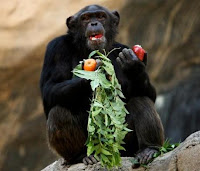Diet
Lemurs (Prosimians/Strepsirhini): Most all lemurs are found in Madagascar and it’s neighboring islands. However, the habitats of these cute fuzzy guys, varies immensely from wet tropical lands to erred desert landscapes. Lemurs stick to a vegetarian diet. They prefer to eat leaves, berries and fruits. They do, however, like to eat bug occasionally and if necessary, smaller animals. I can see where this odd diet would come from the scarcity of fruits and leaves in the desert, making insects or small animals the diet of choice, but in the jungle vegetation is in abundance. http://www.thewildones.org/Animals/lemur.html This is the site my information came from.
Spider Monkey (New World Monkey/Platyrrhini): The spider monkey’s habitat can greatly vary depending on threats or complications in the desired areas. However, they almost never go down to the ground, preferring to spend the bulk of their time in the tops of trees. The ideal habitat is an evergreen or mangrove forest. Spider monkeys are mainly vegetarian. They like to eat a variety of fruits and berries. Occasionally they will eat leaves and bark, or even insects and bird eggs. Living in the tree tops, vegetation can be great but if wind knocks fruits down or the forest isn’t reproducing this may be the cause of the varied diet. Obviously, there are not many other small animals for them to eat all the way up there! http://www.honoluluzoo.org/spider_monkey.htm My Spider Monkey source!
Baboon (Old World Monkey/Cercopithecidae): After checking a variety of sites, I found that all say Baboons have a variety of habitats. The main requirements of a baboon habitat is readily available water and a safe sleeping arrangement. They like to sleep in the tops of tall trees or on the faces of cliffs! The odd part about their preferred environments is that they can go days without drinking water, yet they like to be near it anyway. Their diets consist of many things. The largest quantity being or grass, but they enjoys leaves, fruits, and other vegetarian edibles. The neat thing about baboons that makes them even more adaptable is that they are omnivores. They will eat a variety of meats if they need or want to. I believe this is due to their various habitats. If a vegetarian diet is not of abundance where they live, but smaller animals are, then there you have it. My baboony factoids came from here! http://www.outtoafrica.nl/animals/engbaboon.html
Gibbon (Lesser ape/Hylobatidae): Gibbons are an endangered species that live primarily in Southeast Asia. The spend most of their lives in the tops of trees and are not highly preyed upon because they are quite alone all the way up there and because they are very agile. Therefore, being preyed upon is not the reason they are endangered, deforestation is. It is taking away their habitats and changing they way they live their lives. Gibbons, like baboons, are omnivores. They eat mostly plants and vegetarian fare, but they will also eat small birds, eggs and bugs. Much like the other primates discussed, these animals have had to adapt to their way of living. Trees boast much vegetation but not tons of other animals. So small birds and their eggs sometimes fill that void. Gibbon facts: http://www.enchantedlearning.com/subjects/apes/gibbon/
Chimpanzee (Great ape/Hominidae): Chimpanzees can live in a variety of different habitats. This allows them to spread over a larger area than most primates and occupy about 21 African countries! They, like others monkeys we have described, prefer tree habitats that are high, moist and closed canopied. Chimps are mainly vegetarian, eating only seasonal fruits, leaves and bark. One of the biggest, and most important, parts of their diet, though, are termites. Females need them more than males do and other meat is eaten as well. Larger animals such as pigs and antelope can also be eaten but meats only make up about 5% of their diet. This can make sense when they are traveling from one forest patch to another. This is one of the only times they come down to the ground. http://www.honoluluzoo.org/chimpanzee.htm Chimpy facts came from that site… ß
All of these primates prefer trees and vegetarian eating habits. Only some are omnivores but they all eat insects. I am guessing that this is because of a need for protein. Monkeys are quite agile in terms of habitats. They are resourceful though, and live where they can find sufficient nutrition and safety.










I like the way you organized your blog and how you compared the primates! even though they all seem similar in the way they look they all have different environments but their diets seem to be pretty similar since as you have stated most of them prefer trees and begetarian eating habits!
ReplyDeleteExcellent discussion. Primates in general tend toward omnivous diets, in fact that is one of the general traits of primates. Why do you think that is? What does that suggest about the environmental conditions in which primates evolved to have produced organisms that tend to eat just about anything?
ReplyDeleteI would have to guess that the reason for this widely spread trait is availability. Protein is necessary for organisms to be strong but monkeys who are predominantly tree dwellers must have a hard time finding that, therefore bird eggs come in handy. Monkeys remind me of seagulls... they are scavengers. They are equipped to eat just about anything, so in a time of need, why not eat what is available.
ReplyDelete